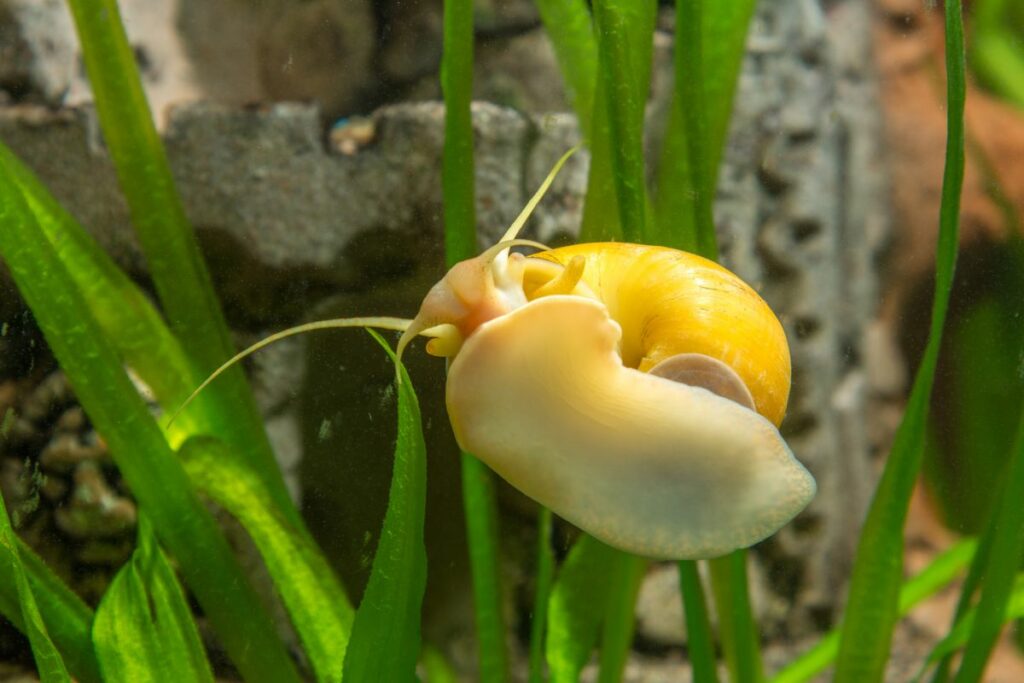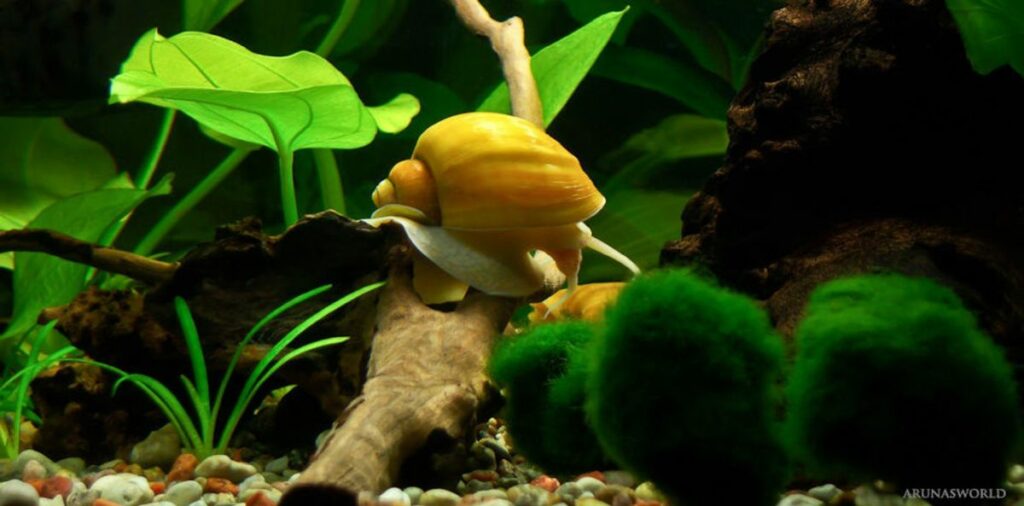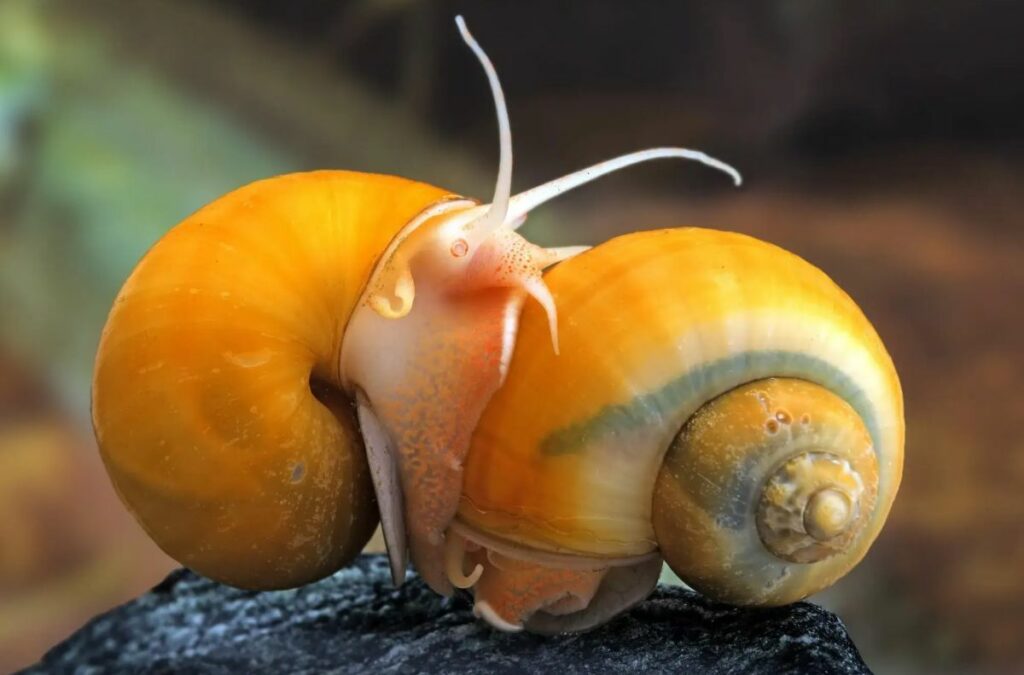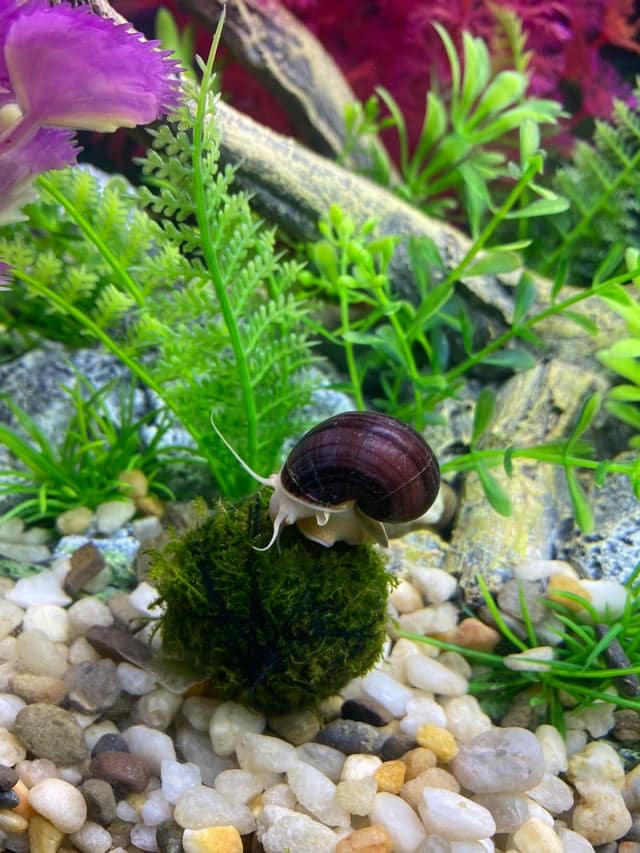Mystery snails are one of the most common types of snail to find in pet stores. They are impressive in size without being too large. They are undemanding to care for. And they come in a wide range of color variations. Are mystery snails the right scavengers for your fish tank?

Understanding the Mystery Snail
The name “mystery snails” applies to several members of the family Ampullariidae. These are all large freshwater snails that have both a lung as well as gills.
Lungs allow these snails to spend time out of the water hunting for food, looking for a new home, or places to lay their eggs so long as they remain moist. In fact, they need access to the surface to breathe from time to time.
Apple and mystery snails also have an operculum, a hard plug that is used to block the entrance of the shell when the snail goes inside.
Mystery and apple snails look similar to one another when small. As they grow up, mystery snails stay small, while apple snails will grow 3 inches or more in diameter.
All mystery snails are scavengers and detritivores. Meaning they feed on leftover organic matter that most other animals won’t touch. Their menu includes dead plant leaves, fish poop, leftover food, and even dead fish.
That said, you should never count on snails cleaning up a dead fish. Ammonia levels will rise to dangerous levels in a home aquarium. The same goes for fish waste and other leftovers.
Mystery snails help process leftovers but they aren’t a substitute for doing regular aquarium maintenance. Keep mystery snails because they are interesting pets in their own right.
- Common Names: Mystery Snail, Mystery Apple Snail
- Scientific Name: family Ampullariidae; often Pomacea bridgesii
- Origin: Worldwide
- Size: 1 to 2 inches
- Aquarium Size: any
- Temperament: Peaceful
- Ease of Care: Very Easy
Mystery Snail Care
Few aquarium pets are as undemanding as mystery snails. They thrive in a wide range of water chemistry conditions and temperatures. So long as their tank mates don’t eat snails, they are guaranteed to get along with them.
How Big Do Mystery Snails Get?
Mystery snails grow 1 to 2 inches in diameter, depending on the exact species you have. Since their lifespan is just a couple of years a baby mystery snail grows fast.
Mystery Snail Tank Size

Any size aquarium will work as a mystery snail tank. They aren’t aggressive and being snails they don’t need much room to explore. Even a betta or other fish living in a small 3 to 5 gallon tank will live alongside a mystery snail or two.
Mystery Snail Water Parameters
The most important water parameters for mystery snails is the pH and hardness. The pH for mystery snails should be neutral to alkaline (pH 7.0+). Acidic conditions leech away the minerals inside of their shells.
Some snails get enough minerals in their diet to make up for this continual wear. But if yours do not, you will see pits start to form as the shell starts to dissolve. Moderate levels of general and carbonate hardness act as a further buffer against dissolved acids.
The ideal mystery snail temperature range is 68-84℉. A range that almost all aquarium fish are comfortable in.
If you can, provide your mystery snails with a soft substrate like sand they will burrow into it. By burrowing, mystery snails aerate the substrate. Which keeps anoxic pockets of toxic gas from forming. They also find scraps of uneaten food that would contribute to ammonia levels rising.
And speaking of ammonia, nitrogenous waste products should be monitored with care. Mystery snails are as hardy as any invertebrate gets. But all inverts are sensitive to ammonia, nitrite, and nitrate levels.
Worse, if a snail dies, it rots fast. Which releases a lot of ammonia, causing more stress and deaths in your aquarium.
Since mystery snails withdraw into their shells when they die, it’s often hard to tell if one is alive. The key is to take a whiff. A dead snail will begin to stink in a few hours. But a live snail just smells like aquarium water.
What Do Mystery Snails Eat?
Like most aquarium snails (except assassin snails), mystery snails are scavengers. Dead plants, bacterial biofilms, and dead animals are a major part of their diet in the wild.
Along with hair algae, green slime algae, and most other types of algae. Mystery snails do not eat brown algae or red algae (black beard and staghorn), however.
Mystery snails also eat leftover fish food. Even when it’s hidden in the gravel they will find it by smell and consume it before it decays. That said, you should feed your fish just enough so leftovers aren’t an issue.
The best way to ensure your snails get enough to eat is to feed them at night. A few sinking wafers or flakes are all that your mystery snails need.
A few parboiled vegetables (zucchini, squash, watermelon, carrot, etc) once per week are also recommended. Vegetables contain calcium and other essential minerals for their shells.
Do Mystery Snails Eat Aquarium Plants?
Mystery snail food includes dead and decaying plant matter. If you see one eating part of a living plant, the snail is eating a patch of dead plant material. Brown and yellowing leaves are a favorite food of theirs.
By eating this dead matter, the mystery snail is helping the plant to recover and grow new leaves faster. Decaying leaves attached to the plant for long periods sometimes allow infectious bacteria to work their way into the main body of the plant. It’s best to let the snail clean up any dead plant material.
A snail that appears to be munching on a live leaf may also be eating the bacterial biofilm that grows on all surfaces in a fish tank.
Mystery snails will eat healthy plants. But only if they have nothing else to eat. If they are eating your plants, try adding boiled vegetables clipped into place against the tank glass. The snails will smell it and switch focus to the dead veggies.
Mystery Snail Tank Mates
Snails are unaggressive and not at all territorial. They even ignore each other unless they are ready to mate. What’s important is making sure that their tank mates won’t harm them.
Known snail eaters include goldfish, koi, loaches, sucker fish, cichlids, and puffer fish. Even if these fish are too small to swallow a snail whole they will damage it by picking at its soft, exposed parts. Fish also find the waving antennae irresistible, which causes major stress to the snail.
Also watch species listed as compatible with mystery snails. You might get an individual fish that decides to try biting your snail. Betta fish are prone to picking at snails when hungry but otherwise get along with them.
These are a few of the safest mystery snail tank mates:
- Tetra fish
- Guppies and other Livebearers
- Gouramis
- Cherry barbs
- Chili Rasboras
- Cory catfish
- Glass catfish
- Dwarf otocinclus
- Zebra danios
- Hatchetfish
- Freshwater shrimp
Mystery Snail Breeding

Assuming you have more than one, you will have mystery snails breeding in your tank. Once they are two months in age, males and females start looking for partners.
Sexing them isn’t too difficult. When the snail crawls across the aquarium glass, look for the male’s penis inside of its shell. It is located next to the gills in the upper part of the mantle.
Once the female’s eggs are fertilized, she will lay them outside of the water. If your tank has a few centimeters of dry glass, check there every so often. The eggs are yellow, orange, or pink and laid in a solid mass of around 100.
The eggs take 2 to 4 weeks to develop, depending on the species of snail and the air temperature. The babies will hatch and drop right into the water, starting a new generation of mystery snails. I cover the topic of snail eggs in even more detail right here.
Conclusion
If you are looking for your first snail, it does not get any easier than keeping a mystery snail. The red, blue, yellow, and albino color morphs are very attractive. And so long as you keep an eye out for any egg masses, mystery snails won’t fill your aquarium with baby snails.
FAQs
Mystery snails do have eyeballs. They are so tiny that they are almost invisible, especially if you have a dark colored snail. The eyes look like black pin pricks at the end of each eyestalk.
Mystery snails are an egg-laying species. Some snails are hermaphrodites but mystery snails have distinct male and female sexes. The eggs are laid just above the water’s surface, safe from aquatic predators. But close enough for the babies to drop right into the water when they hatch.
Mystery snails do eat algae. They are gentle on leaves and do a great job at cleaning delicate plants. Mystery snails eat most forms of green algae but won’t touch brown or red algae varieties.


